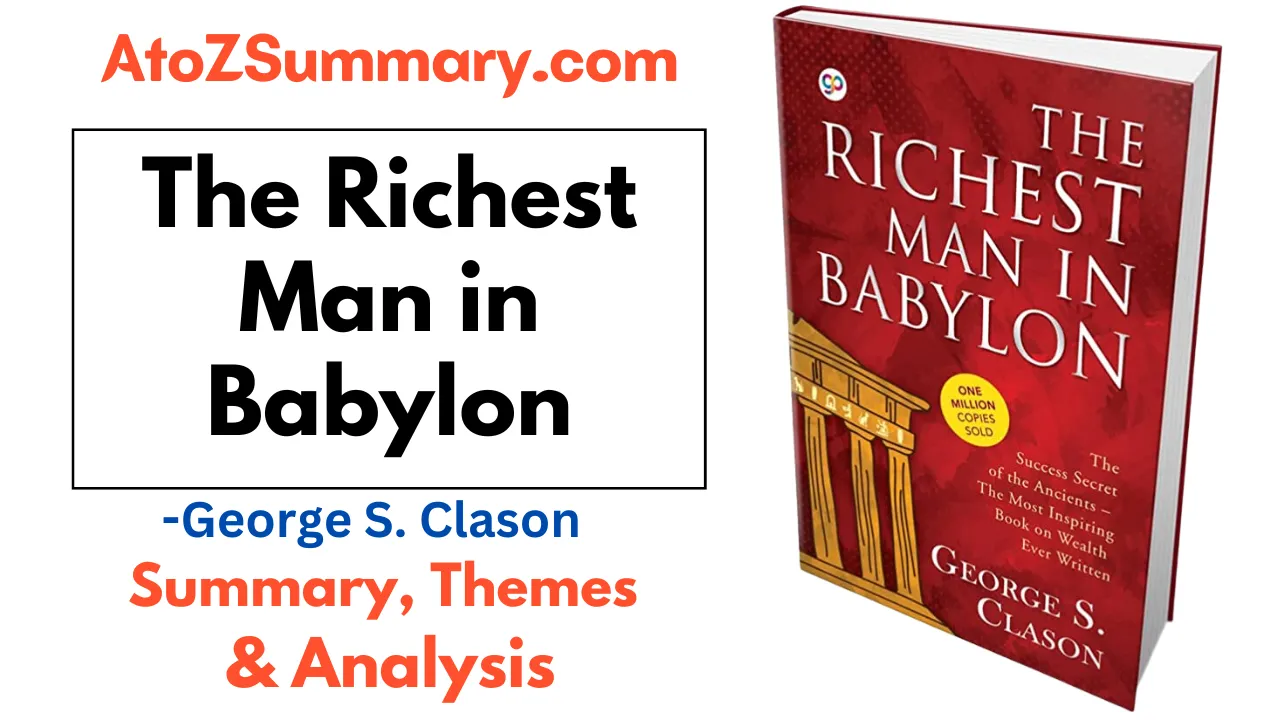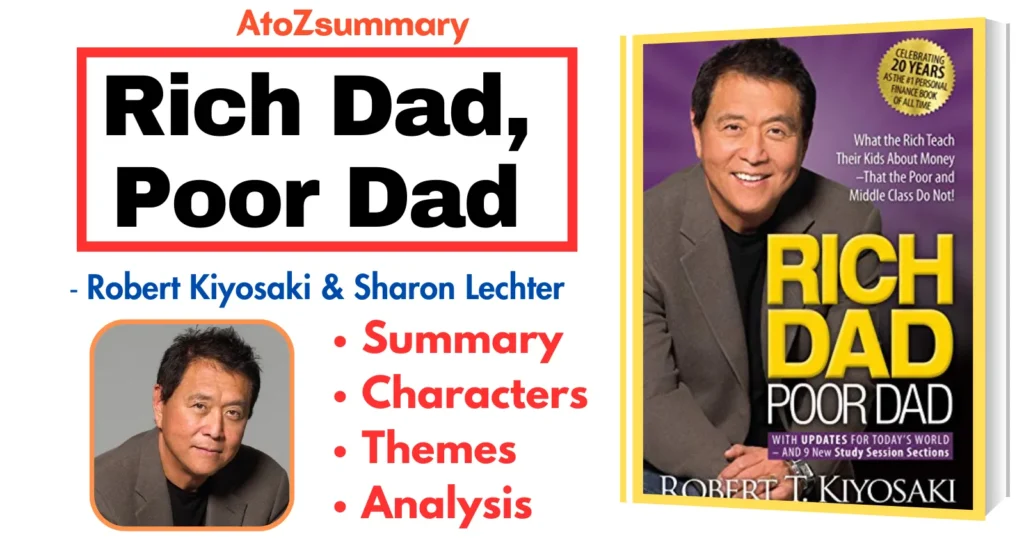| Title | The Richest Man in Babylon |
| Author | George S. Clason |
| Genre | Personal finance, self-help, business |
| Publication date | 1926 (original publication), 2020 (revised and updated edition) |
| ISBN-10 | 0451205367 |
| ISBN-13 | 978-0451205360 |
| Pages | 144 |
| Total No. of Chapters | Chapter 1 : The Man Who Desired Gold Chapter 2 :The Richest Man in Babylon Chapter 3 :Seven Cures for a Lean Purse Chapter 4 :Meet the Goddess of Good Luck Chapter 5 :The Five Laws of Gold Chapter 6 :The Gold Lender of Babylon Chapter 7 :The Walls of Babylon Chapter 8 :The Camel Trader of Babylon Chapter 9 :The Clay Tablets from Babylon Chapter 10 :The Luckiest Man in Babylon Chapter 11 :An Historical Sketch of Babylon (optional chapter) |
| Key themes | Wealth creation, personal finance, saving money, investing, avoiding debt, financial discipline |
George S. Clason’s timeless classic “The Richest Man in Babylon” offers economic guidance that is still relevant today. The story of Arkad, who rose to prominence as Babylon’s richest man due to smart financial decisions, is told in this book, which is set in ancient Babylon. The plot of the book revolves around a number of parables that impart crucial financial principles.
Characters in “The Richest Man in Babylon”
- Arkad: The book’s main character, is the richest person in Babylon. He is a self-made man who was a meager scribe in his early years before becoming affluent thanks to his understanding of finances and his aptitude for saving and investing.
- Bansir: He is a chariot maker who is having financial difficulties. Although he puts in a lot of effort, he lacks financial management skills. He is taken under Arkad’s wing and is taught the fundamentals of investing and saving.
- Kobbi: A musician who is having financial difficulties. He feels he is not being compensated adequately for his talent and is jealous of Bansir’s success. He learns from Arkad that if he wants to accumulate wealth, he must make prudent financial decisions.
- Dabasir: A trader who is constantly looking for a quick way to gain money. Instead of investing or preserving money, he prefers to take risks, which frequently end in losses. Arkad instructs him that persistently saving and investing over time is the best way to amass riches.
- Mathon: A farmer who is having a difficult time making ends meet. Though he puts in a lot of effort, the drought and other natural calamities have taken a toll on him. He learns from Arkad the value of diversifying his sources of income and setting aside money for unexpected expenses.
- Algamish: A rich guy who pays Arkad to instruct his son on financial concepts. He is one of Arkad’s most ardent followers after being struck by the wisdom of the man.
A historical sketch of Babylon
George S. Clason provides readers with background information about Babylon, one of the oldest and richest cities in the world. On the banks of the Euphrates River, in what is now Iraq, Babylon was founded more than 8,000 years ago, according to Clason. He asserts that Babylon’s prosperity was a result of its ideal position, which made it a key trading hub linking the East and the West.
Chapter 1: The Man Who Desired Gold
The protagonist, Arkad, a young Babylonian chariot maker, is introduced to us in this first chapter. Arkad struggles to survive on his own and feels unfulfilled in life despite his long hours and hard labor. He sets out to consult the richest man in Babylon because he aspires to wealth and financial freedom.
Chapter 2: The Richest Man in Babylon
In this chapter, Arkad encounters Bansir, the richest man in Babylon and learns about his rise from destitution to affluence. Bansir divulges to Arkad his wealth-building strategies, which include saving at least 10% of one’s salary, living within one’s means, and making sensible investments.
Chapter 3: Seven Cures for a Lean Purse
In this chapter, the author presents seven practical and timeless principles for achieving financial success and wealth accumulation.
“Start Thy Purse to Fattening” is the first cure and it highlights the importance of saving some of one’s money. The author suggests setting away some amount of income for savings and adhering to a strict budget to help people avoid debt and financial difficulties.
“Manage Thy Expenditures,” the second cure, offers guidance on avoiding excessive spending and impulsive purchases. To make sure that one’s spending corresponds with one’s financial goals, the author advises making a budget and prioritizing costs.
“Make your investments to multiply“, the third cure, emphasizes the significance of investing and making one’s money work for them. To increase one’s wealth, the author advises consulting with educated experts and making investments in successful businesses.
The fourth cure, “Guard Thy Treasures from Loss,” highlights the significance of guarding one’s possessions against loss, theft or destruction. The author advises finding reputable and trustworthy financial institutions and insurance companies to protect one’s fortune.
The fifth cure, “Make of Thy Dwelling a Profitable Investment,” advises turning one’s house or other property into a source of revenue. To increase income, the author advises renting out extra space or using one’s property.
The sixth cure, “Ensure a Future Income,” warns against depending entirely on one’s present income and promotes retirement planning and other forms of long-term financial security. The author advises setting money aside for the future and investing in long-term assets that will generate a consistent flow of income.
“Increase Thy Ability to Earn“, the final cure, highlights the significance of consistently enhancing one’s abilities and knowledge in order to raise one’s earning potential. The author advises making educational and professional investments to raise one’s marketability in the labor market.
Chapter 4: Meet the Goddess of Good Luck
Chapter 4 of “The Richest Man in Babylon” introduces the character of the “Goddess of Good Luck“, who represents the opportunities that come to those who are prepared to receive them.
Arkad tells them the story of how he met the “Goddess of Good Luck.” He explains that he was once a poor scribe who diligently invested the modest amount of money he saved each year. He once met a man who gave him the chance to invest in a successful business. Arkad was apprehensive to invest all of his savings, but he thought back to Algamish’s words of wisdom, who said to “attract good luck by being prepared for it.” Arkad decided to take a chance and put his whole savings in the business, which was a huge success.
After making a wise investment, Arkad was introduced to a powerful and wealthy man, who gave him a job offer as a financial advisor. He kept making wise investments and quickly accumulated a large fortune.
Chapter 5: The Five Laws of Gold
In this chapter, Arkad shares the five laws of gold with his friend Dabasir. The laws include:
- 1st Law of Gold: Any person who invests at least one-tenth of their income to build an estate for their future and the future of their family will receive gold willingly and in growing quantities. This rule places a strong emphasis on the value of setting aside some of one’s income for the future and carefully investing it to generate wealth and financial security.
- 2nd Law of Gold: This rule places a strong emphasis on the necessity of correctly investing one’s money in order to increase wealth. It also stresses the value of avoiding get-rich-quick schemes and investing with patience and discipline.
- 3rd Law of Gold: This law emphasizes the value of investing in companies and projects that one is familiar with or knowledgeable about and consulting professionals before making investment decisions.
- 4th Law of Gold: This rule highlights the value of making secure and safe investments rather than taking a chance on speculative or hazardous investments that can result in losses.
- 5th Law of Gold: This law strongly emphasizes that in order to achieve financially, one must be willing to push themselves beyond of their comfort zones and take calculated risks when investing. Additionally, it highlights how important it is to confirm that the risks are legitimate, justified, and taken seriously.
Chapter 6: The Gold Lender of Babylon
Arkad learns in this chapter the value of credit and borrowing in accumulating riches. He meets with Mathon, a wealthy lender who shares his views on making loans and charging interest. Mathon highlights the need of being dependable and creating lasting business ties.
Chapter 7: The Walls of Babylon
Arkad recognized a chance to use his money to leave a long-lasting impression on Babylon since the city needed sturdy walls to keep out invaders. He enlisted the assistance of the inhabitants of Babylon in the construction of the walls and gave a sizable financial contribution himself.
The citizens of Babylon came together to build the walls in spite of several challenges and setbacks, and as a result, the city was considerably safer and more secure. Because of his contributions to the city, Arkad won the love and adoration of the Babylonians to a new level. He constantly improving people’s lives by leveraging his riches and power.
Arkad concludes the chapter by discussing the value of giving back to one’s community and using riches to effect change. He is appreciative of the chance to return favor to the city that had done so much for him and acknowledges that his achievement would not have been possible without the help and sacrifice of others.
Chapter 8: The Camel Trader of Babylon
In this chapter, the author tells the story of a man named Dabasir who is a camel trader in the city of Babylon.
Although being a prosperous trader, Dabasir is constantly looking for ways to expand his money. He encounters Arkad, regarded as the richest man in Babylon, one day. Dabasir accepts Arkad’s offer to teach him the secrets of wealth, but he is informed that success depends on his willingness to abide by certain rules.
Arkad teaches Dabasir the benefits of saving and investing. He tells him to make wise investments with the money he sets aside year. He also teaches him the value of saving money rather to just spending it on unnecessary things.
Dabasir pays attention to Arkad’s guidance and starts saving money and making investments. He also begins to consider his company more strategically, looking for fresh chances for development and growth.
Chapter 9: The Clay Tablets from Babylon
In this chapter, Arkad comes across some old clay tablets that teach him important lessons about money management and achieving financial success. He gains knowledge about the significance of long-term investing and the impact of compound interest.
Chapter 10: The Luckiest Man in Babylon
In this last chapter, Arkad considers his journey and realizes that he is now among the richest people in Babylon. He credits the ideas and guidance he gained from Bansir, Mathon, Dabasir and the clay tablets for his achievement. He exhorts people to put these principles into practice in their own lives so they can achieve financial freedom.
Themes and Messages in “The Richest Man in Babylon”
- Pay Yourself First: The book places a strong emphasis on the value of setting aside and investing a portion of one’s income before using it for other purposes. Arkad’s rise to wealth in Babylon as a result of adhering to the maxim “keeping one-tenth of all I earn” serves as an example of this idea.
- Live Within Your Means: The book emphasizes the significance of doing so and avoids taking on too much debt. The story of Dabasir serves as an illustration of this concept since he discovered the hard way that borrowing above his means can result in financial catastrophe.
- Take Reasonable Risks: The book encourages readers to take reasonable risks when it comes to their finances. The story of Algamish shows how taking calculated risks can result in huge rewards.
- Seek Knowledge: The book emphasizes the importance of seeking knowledge and wisdom about financial matters. The story of Bansir and Kobbi demonstrates that seeking the advice of knowledgeable people can help one make better financial decisions.
- Give Back: The book encourages readers to give back to their community and share their wealth with others. The story of Arkad’s friends shows that true wealth includes not only financial success but also generosity and compassion towards others.
About the Author-George S. Clason
| Field | Information |
|---|---|
| Full Name | George Samuel Clason |
| Birthdate | November 7, 1874 |
| Death Date | April 7, 1957 |
| Nationality | American |
| Occupation | Businessman, writer |
| Known for | Writing “The Richest Man in Babylon” |
| Education | University of Nebraska-Lincoln, Bachelor of Arts |
| Notable Works | “The Richest Man in Babylon” |
| Spouse | Ida Ann Venable & Anna Burt |
FAQs
What is “The Richest Man in Babylon” about?
The book “The Richest Man in Babylon” discusses personal finance and acquiring wealth. It offers timeless advice on handling money and accumulating wealth in the form of parables set in ancient Babylon.
What are some of the key lessons in “The Richest Man in Babylon”?
Some of the key lessons in “The Richest Man in Babylon” include paying yourself first, living within your means, investing wisely and seeking advice from knowledgeable experts.
Is this only for people interested in finance?
The film “The Richest Man in Babylon” isn’t just for those with an interest in money. Regardless of their area of interest, everyone trying to improve their life can benefit from the book’s teachings on fiscal responsibility, self-discipline and tenacity.






!["A Man Called Ove" Summary,Themes,Characters & Synopsis [Fredrik Backman] "A Man Called Ove" Summary,Themes,Characters & Synopsis [Fredrik Backman]](https://atozsummary.com/wp-content/uploads/2023/08/A-Man-Called-Ove-SummaryThemesCharacters-Synopsis-Fredrik-Backman-1024x597.webp)
![Water for Elephants Summary,Themes,Charactres & Synopsis [Sara Gruen] Water for Elephants Summary,Themes,Charactres & Synopsis [Sara Gruen]](https://atozsummary.com/wp-content/uploads/2023/08/Water-for-Elephants-SummaryThemesCharactres-Synopsis-Sara-Gruen-1024x597.webp)


![The Glass Castle Summary,Themes,Characters & Synopsis [by Jeannette Walls] The Glass Castle Summary,Themes,Characters & Synopsis [Jeannette Walls]](https://atozsummary.com/wp-content/uploads/2023/08/The-Glass-Castle-SummaryThemesCharacters-Synopsis-Jeannette-Walls-1024x597.webp)
